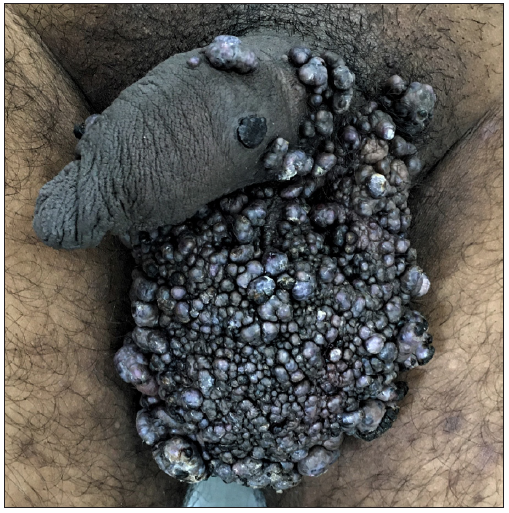Giant angiokeratomas of scrotum
Corresponding author: Dr. Kavita Poonia, Department of Dermatology, AIIMS, Bathinda, India. kavitapoonia777@gmail.com
-
Received: ,
Accepted: ,
How to cite this article: Poonia K, Chojer P, Kapatia G. Giant angiokeratomas of scrotum. Indian J Dermatol Venereol Leprol. 2024;90:835. doi: 10.25259/IJDVL_1225_2023
Case details
A man in his thirties presented with multiple violaceous to blackish, discrete to coalescing keratotic papules and nodules on the penis and scrotum for 1.5 years [Figure 1]. The lesions were painless and non-itchy. However, the patient had multiple episodes of spontaneous bleeding from the lesions. His medical history was unremarkable and he was not on any regular medication. On examination, no active bleeding or palpable swelling was noticed within the scrotum. However, dried encrusted blood was observed in between the lesions. Regional lymph nodes were not enlarged. The differential diagnoses of angiokeratoma of scrotum, lymphangioma cirumscriptum, and Kaposi sarcoma were considered and a skin biopsy was sought. Histopathology demonstrated numerous dilated and thin-walled congested capillaries lined by flattened endothelial cells in the papillary dermis. Mild infiltration by chronic inflammatory infiltrate comprising of lymphocytes and plasma cells was also noted. Hemosiderin pigment was also identified within the lesion. The adjacent epidermis showed acanthosis with elongation of rete ridges and hyperkeratosis. However, no dilated lymphatic channels were seen. These findings were consistent with angiokeratoma of the scrotum. We would like to report this case because of the florid manifestation of a common benign condition.

- Multiple violaceous to blackish, discrete to coalescing keratotic papules and nodules on the penis and scrotum.
Declaration of patient consent
The authors certify that they have obtained all appropriate patient consent.
Financial support and sponsorship
Nil.
Conflicts of interest
There are no conflicts of interest.
Use of artificial intelligence (AI)-assisted technology for manuscript preparation
The authors confirm that there was no use of artificial intelligence (AI)-assisted technology for assisting in the writing or editing of the manuscript and no images were manipulated using AI.





